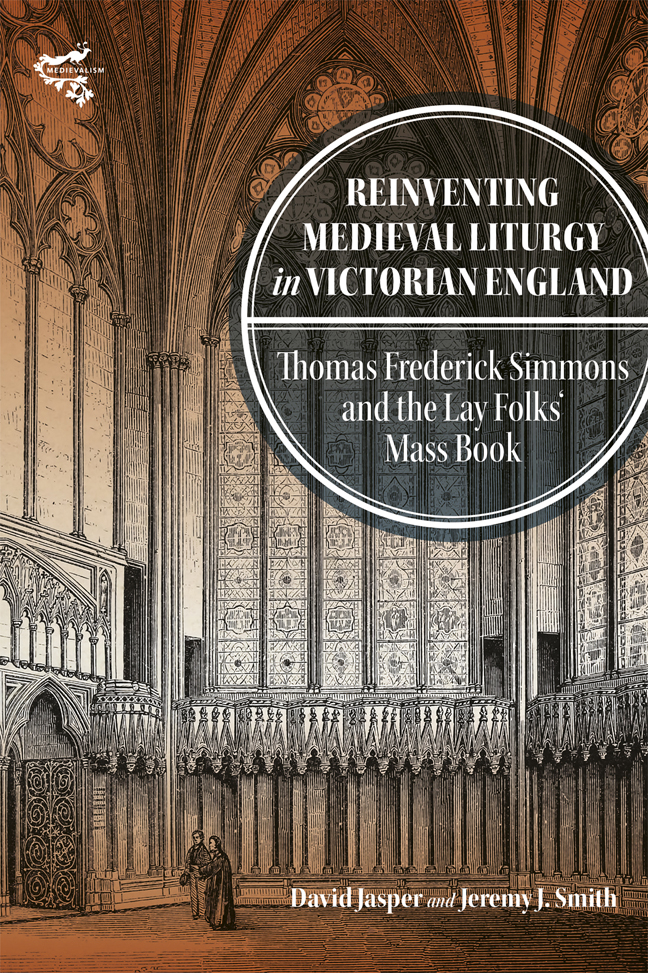 Reinventing Medieval Liturgy in Victorian England
Reinventing Medieval Liturgy in Victorian England Book contents
- Frontmatter
- Dedication
- Contents
- List of Plates
- Preface
- A note on citations
- List of abbreviations
- Introduction: Imagining the Past
- 1 Thomas Frederick Simmons and The Lay Folks’ Mass Book
- 2 Re-imagining Medieval Devotion: Nineteenth-Century Conceptions of the English Church
- 3 Simmons and the Early English Text Society
- 4 Simmons as Editor: The Philologist
- 5 Simmons as Editor: The Liturgist
- 6 Simmons as Parish Priest, and Liturgical Reform in the Victorian Church of England
- 7 The Afterlives of The Lay Folks’ Mass Book
- Conclusion: Liturgical Moments in Time
- Plates
- Appendix I The Lay Folks’ Mass Book: Text and Translation
- Appendix II The Lay Folks’ Mass Book and the Sarum Rite
- Bibliography
- Index
- Miscellaneous Endmatter
6 - Simmons as Parish Priest, and Liturgical Reform in the Victorian Church of England
Published online by Cambridge University Press: 02 March 2024
- Frontmatter
- Dedication
- Contents
- List of Plates
- Preface
- A note on citations
- List of abbreviations
- Introduction: Imagining the Past
- 1 Thomas Frederick Simmons and The Lay Folks’ Mass Book
- 2 Re-imagining Medieval Devotion: Nineteenth-Century Conceptions of the English Church
- 3 Simmons and the Early English Text Society
- 4 Simmons as Editor: The Philologist
- 5 Simmons as Editor: The Liturgist
- 6 Simmons as Parish Priest, and Liturgical Reform in the Victorian Church of England
- 7 The Afterlives of The Lay Folks’ Mass Book
- Conclusion: Liturgical Moments in Time
- Plates
- Appendix I The Lay Folks’ Mass Book: Text and Translation
- Appendix II The Lay Folks’ Mass Book and the Sarum Rite
- Bibliography
- Index
- Miscellaneous Endmatter
Summary
Simmons as parish priest, 1853–1884
On 25 January 1853, Thomas Frederick Simmons was licensed as perpetual curate of Holme-on-the-Wolds in the East Riding of Yorkshire; he had clearly been identified as the man to develop the projected new parish of Dalton Holme, which included not only Holme-on-the-Wolds but also nearby South Dalton, both part of the great Hotham estate.
Between 1840 and 1876 some 1,727 new churches were built in England, and not least among them was the grand parish church of St Mary, South Dalton. The old church of St Peter’s was in poor condition2 and on 15 March 1858 work was begun on a new church fifty yards north of the old building. Lavishly financed by the third Baron Hotham, St Mary’s Church was completed in 1861 and on 6 August in the same year, the benefices of Holme-on-the-Wolds and South Dalton were officially united, with Simmons instituted as the Rector of Dalton Holme.
General Beaumont Hotham (1794–1870), Simmons’ patron, was a distinguished soldier – a veteran of the Battle of Waterloo – and it seems probable that military connections through Simmons’ father and brother brought him to Dalton Holme. Lord Hotham was unmarried, devout, and eccentric, and local gossip maintained that he spent his entire fortune on the church to prevent his nephew from inheriting it. Though hardly the lot, Hotham did spend the enormous sum of £25,000 on the new church of St Mary’s. The church was further extended in 1872.
John Loughborough Pearson, the architect, was – as already noted6 – an admired builder of churches in the English Gothic style, later to be known for his work in the Early English style at St Augustine’s, Kilburn (1871), as architect of Truro Cathedral (1880), and for his restorations at Westminster Abbey. Pearson had become a member of the Ecclesiological Society only in 1859, but his work at Dalton Holme quickly attracted the Society’s attention and approval. A review (February, 1862) of St Mary’s Church in The Ecclesiologist praised Pearson’s work, albeit with some qualifications:
The style is Middle-Pointed, of strictly English character, and of a very ornate type…. The absence of a stone roof (considering the sumptuousness of the struc-ture) and of colour, constructional or otherwise, is however, to be regretted.
Pearson was personally a devout man, and his being chosen as the architect of St Mary’s church was not without significance.
- Type
- Chapter
- Information
- Reinventing Medieval Liturgy in Victorian EnglandThomas Frederick Simmons and The 'Lay Folks' Mass Book', pp. 119 - 144Publisher: Boydell & BrewerPrint publication year: 2023


